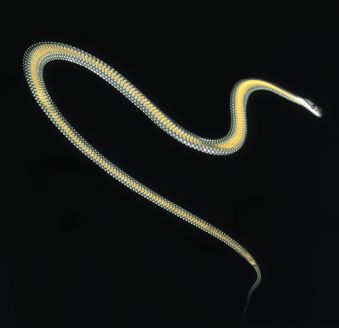Flying Snakes: New Videos Reveal How They Do It

You might not think snakes need any more tools in their box of fright tactics. However, some of these slithering reptiles are dramatic flyers.
Jake Socha of the University of Chicago has been studying snakes' ability to act like birds for eight years. Today he revealed just how good they are at winging it.
"Despite their lack of wing-like appendages, flying snakes are skilled aerial locomotors," he said.
Like a Frisbee
Snakes join birds, insects, bats, squirrels and even ants in the realm of aerial prowess. So just how do they do it?
"First of all, they flatten their bodies out all the way from their head to tail," Socha told LiveScience. "Snakes are part body and part tail, and they have ribs up until the tail. They flatten their ribs and make themselves Frisbee-like in form."
This gets them aerodynamically fit for gliding.
Get the world’s most fascinating discoveries delivered straight to your inbox.
"As [the snake] starts falling, it starts sending large S-shaped waves through its body mostly by moving its head from side to side," Socha explained. "It also keeps its body parallel to the ground."
Since they don't have wings, snakes control their flight patterns by sort of slithering through the air. By undulating their bodies in an exaggerated S-shaped pattern, they maintain in-flight stability. It's sort of like how a tight-rope walker shifts weight from side to side to keep balance.
To get airborne, snakes either hang from a branch, search for a comfy landing spot, and drop, or they actively leap off the branch, which gives them a little more height and allows them to glide farther.
Socha isn't quite sure why snakes developed the ability to glide, but he suggests that they do it to save energy.
"Say you're in one tree and you want to get to another tree that's 50 feet away. You would have to climb down, slither across, and climb up the tree," he explained.
Turning in mid-air
The paradise tree snake seems to be the only species of flying snake that can turn mid-flight. Socha has found.
"There are some small clues to how turning works, but I don't have the details yet," he said. "When they are making the turn, it seems that the actual turning only occurs when their head is pointing in the direction they want to turn in."
Socha also studied Chrysopelea ornata, the golden tree snake. Both snakes live in the trees in the lowland tropical rainforests in South and Southeast Asia.
Most flying snakes - there are three additional species - grow about 3 to 4 feet long. They secrete a mild venom, but this is only hazardous to small prey - such as lizards, birds, frogs, and bats - and they are officially classified as harmless to humans.
Socha's findings will be detailed in the May 15 issue of the Journal of Experimental Biology. Videos of the snakes in flight are available here.
Related Stories


